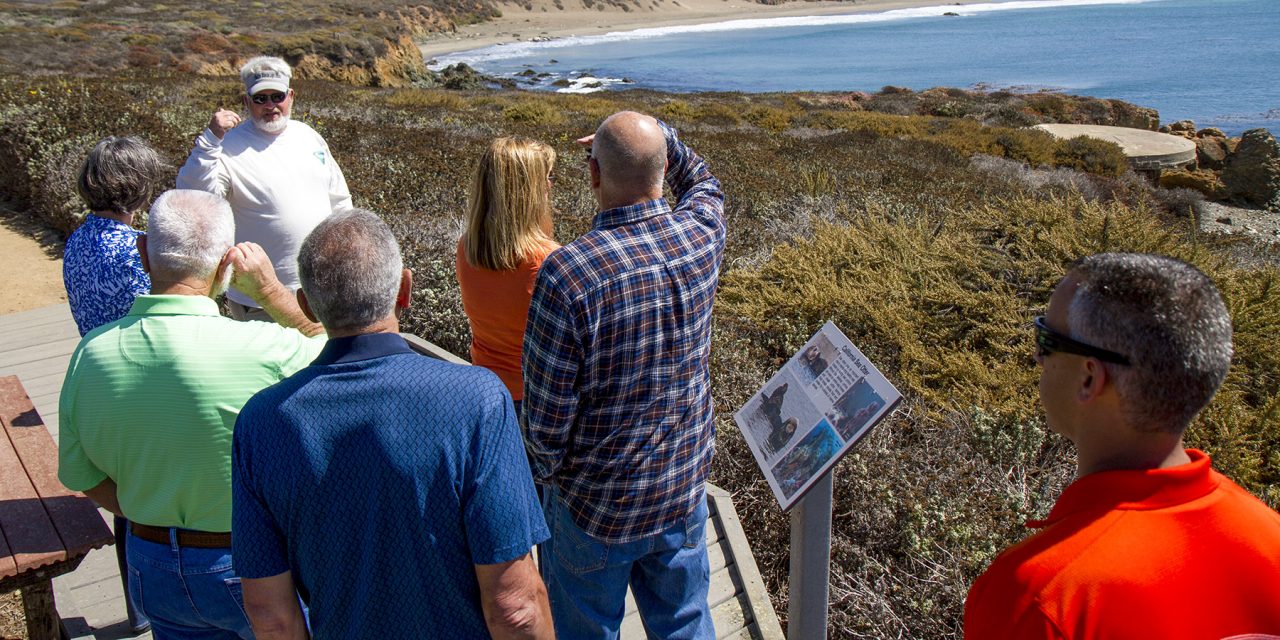How the Atascadero Greyhound Foundation Shifted from Funding Sports to Preventing Tragedy
In 1994, the Atascadero High School track was a sad sight.
“It was a 6-lane dirt track,” said Donn Clickard, who was the athletic director at the time.
Jim Stecher, who was the principal, remembers an even worse image.
“It flooded every winter,” Stecher said. “It was like a river.”
With that in mind, the Atascadero Athletic Foundation was formed to raise funds for a sleek, all-weather, nine-lane track. But in time, the foundation would take on a much greater cause, responding to a deadly national trend that also had tragic implications for Atascadero.
“We’re not just an athletic foundation,” said Rolfe Nelson, former principal and dean of students at Atascadero Junior High. “We’re so much more.”
Re-named the Atascadero Greyhound Foundation roughly 15 years ago, Clickard hopes it becomes a model for other communities. Because what started as an organization to raise money for athletics now includes funding for drug counseling, mentoring programs, after-school enrichment programs, a coffee company and more.

But in the beginning, it really was just about sports.
Clickard and Stecher were members of a group that regularly played basketball at lunch and went camping together in Porterville. As their friendships grew, they brainstormed ways to improve athletic facilities.
After the foundation funded the new track, it turned its attention to other needs, including lights at the football field.
“It was basically a bunch of candles and flashlights before,” said Clickard, who is retired as an educator but still a member of the Atascadero Unified School District board.
With the foundation came funding for football bleachers, improvements to the baseball and softball fields and a new concession stand, The Top Dog.

“There are a number of things associated with the beginning of the Greyhound Foundation that continue today,” Clickard said, adding that the foundation is currently looking at plans for a new swimming pool.
Part of the foundation’s fundraising efforts come from events such as the Hares ‘N’ Hound, a 5K run, and All Comers Meet, a track and field event for all ages.
Those events also provide activities for families, said Robyn Schmidt, director of both.
“I feel that it provides a healthy activity as well as showing them community support through the community volunteers and parent volunteering that happens impromptu,” she said.
The foundation also heads the Greyhound Hall of Fame. But as the goals of the foundation began to shift, its name changed, Clickard said, initially to appease a grant application. But eventually, he added, it just made sense.
“It does reflect that we are not just doing things for athletic facilities as a main project,” Clickard said.
That became especially evident around 2011, when Lighthouse Atascadero was formed under the foundation’s umbrella.
At the time, the county schools drug rehab program was treating 12 students from Atascadero with heroin addictions. Meanwhile, four fatal overdoses involving local young people drew even more attention to the problem.
Clickard was a godfather to two of those. And during the funeral of one, the deceased’s father approached Clickard and said, “Donn, we have to do something.”
In 2011, Lighthouse Atascadero started as an intervention program. Nelson suggested the name Lighthouse because lighthouses symbolize rescues and avoiding disasters. Its tagline, “We, not me,” suggests that the problem afflicts and will be addressed by a community.

In recent years, opioid-related deaths have been especially troubling. Prescription drug misuse, which includes opioids, is among the fastest growing drug problems in the United States, according to the U.S. Department of Health and Human Services. And in 2015, 4,235 young people aged 14-24 died due to overdoses, many from opioids.
Even as celebrities such as Prince and Tom Petty died from opioid addiction, many didn’t know adolescents were becoming addicted. Others just didn’t address the issue.
“A lot of communities didn’t want to admit there was a problem,” said Nelson, first president elect and treasurer of the foundation.
While opioids often come in the form of legal prescription drugs, it also includes heroin, which is not legal. Educators involved with the foundation had always seen students struggle with additions. But the opioid crisis, they said, was different.
“The drugs changed,” said Stecher, current president of the foundation. “They became much more potent. People don’t know what they’re getting into.”
With Lighthouse, even more funding was needed. So Clickard and Nelson approached Joseph and Isabel Gerardis, owners of Joebella Coffee Roasters in town, about starting a coffee business – modeling a program Clickard had heard about in Bakersfield.
Joebella provides coffee to Lighthouse Coffee at a price below their wholesale. Then students at Paloma Creek High School sell the coffee to individuals, businesses and restaurants to raise funds for the Lighthouse program.

“We roast the coffee and package it with Lighthouse labels that the school prints,” Joseph Gerardis said. “We give each new class of students a tour of our facility and the roasting process to help educate them about the coffee industry – and the particular coffees they are selling.”
Lighthouse Coffee had over $18,000 in sales in 2018 alone, and students who sold it gained valuable entrepreneurial skills.
With added funding, more Lighthouse programs and features were formed, adding a therapist who helps students with mental health and addiction issues, a wellness center, afterschool programs and a reality tour that offers a stark dramatization of an overdose.
“The variety of programs offer young folks many ways to learn and grow,” said Atascadero Mayor Heather Moreno, who has been on the Lighthouse Committee for roughly six years. “One particular program that amazes me is L.A.M.P. (Lighthouse Atascadero Mentoring Program), giving high school students the opportunity to mentor middle schoolers. The leadership skills, self esteem and confidence that grow from this is incredible. What Atascadero is doing is a model for the country.”
The foundation, which includes individuals from several different careers, does still support athletics and band, programs it believes helps steer students from drugs. But no one anticipated its mission would change so dramatically. And many, like Stecher, are glad it did.
“This is our community,” Stecher said. “This is our show.”
According to local police and fire departments, the number of overdoses and drug-related deaths in Atascadero have decreased in the past five years — a figure many attribute to Lighthouse efforts. The most effective component of Lighthouse, said Lt. Jason Carr, of the Atascadero Police Department, might be in raising awareness and creating an environment conducive to discussion.
“We are working hard to remove the stigma associated with addiction so that families and friends can seek the help they need in dealing with any addiction issues,” said Carr, who is also involved with Lighthouse. “We have been able to create a dialogue with young adults about the dangers of addiction and also listened to what young adults in our community are being exposed to on a daily basis.”
As the foundation prepares for a couple of books that will help spread the word of what has been done, Clickard said the foundation isn’t just resting on its laurels.
Since Lighthouse Atascadero was founded, it has raised around $300,000 through coffee sales, golf tournaments, fun runs, the Dancing with Our Stars fundraising event, donations and sponsors. And those efforts will continue, Clickard said.
“We’re not done.”












